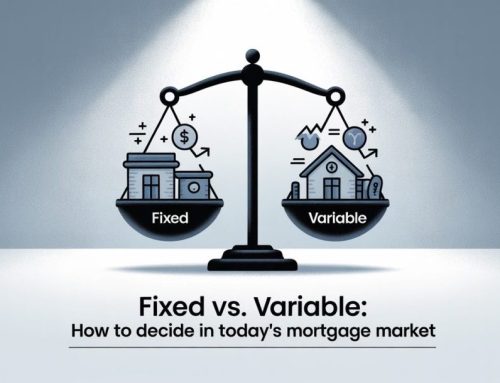I’m looking forward to the day when I can start blogging about falling mortgage rates. Unfortunately, we are not there yet as rates are still on the rise with more lenders increasing their fixed rates as recently as this morning.
Last week, the Bank of Canada surprised everyone with another 0.25% increase to their overnight rate, which brought the prime rate up to 6.95%… the highest since early 2001. While there were some economists expecting the increase, the vast majority believed the BoC would keep the status quo.
Whenever there is a surprise move by the Bank of Canada, bond yields generally react accordingly. In this case, the surprise was a rate hike, which resulted in a large spike immediately thereafter.
There was already upward pressure on fixed rates, but the precipitous upward movement in bond yields last Wednesday was enough for some mortgage lenders to start increasing their fixed rates by as much as 0.30% the next day.
Other lenders followed.
As of this morning, virtually all lenders have now increased their fixed rates, some by as much as 1.00%.
But how much higher will they get, and will we see any more increases from the Bank of Canada?
What we can Expect from the Bank of Canada
As we all know, inflation is a problem. The Bank of Canada has made it clear that they will do whatever it takes to bring inflation under control. They are not taking any chances and would rather err on the side of caution by hiking rates further if there is any doubt.
If they were to keep the rate unchanged, then they run the risk of inflation continuing to rise. This is not a chance they are willing to take.
That doesn’t mean another hike from the BoC in July is imminent, however, it is now expected. Their decision will largely depend on the next CPI inflation report which is scheduled for release on June 27th.
The Bank of Canada is still optimistic that we will see inflation down to 3% by mid-year. Well, here we are, pretty much smack dab in the middle of 2023. While it may not drop quite this low by June 27th, it is widely expected to at least drop into the 3% range. Then hopefully down to 3% with the following CPI inflation report scheduled for July 18th.
Updated Forecasts from the Big Six Banks
While we’re still waiting on TD and Scotia to update their forecasts following last week’s Bank of Canada announcement, the other four were quick to make adjustments.
RBC, BMO, CIBC, and National Bank are all now forecasting one more rate hike in the 3rd quarter of this year.
BMO and National Bank are still forecasting rate cuts to start in the first quarter of 2024. Keep in mind, this is only 7-9 months away.
CIBC and RBC are expecting the cuts to start in the 2nd quarter next year.
I’ve outlined their forecasts by quarter in the table below.
| Q3 2023 | Q4 2023 | Q1 2024 | Q2 2024 | Q3 2024 | Q4 2024 | 2024 Total | |
| BMO | +0.25% | N/C | -0.25% | -0.25% | -0.25% | -0.25% | -1.00% |
| NATIONAL | +0.25% | N/C | -0.25% | -0.50% | -0.25% | -0.25% | -1.50% |
| CIBC | +0.25% | N/C | N/C | -0.50% | -0.75% | -0.25% | -1.50% |
| RBC | +0.25% | N/C | N/C | -0.50% | -0.50% | -0.50% | -1.50% |
N/C = no change
What we can Expect from Fixed Mortgage Rates
Fixed mortgage rates are heavily influenced by bond yields which have increased by roughly 30% since the beginning of May. This has put considerable upward pressure on fixed rates which has resulted in lenders increasing their rates by 0.40% to as much as 1.00%.
This will also have a negative effect on borrowing power. In other words, you can now expect to qualify for less than you would have before the increases took effect.
If the Bank of Canada increases their rate by another 0.25% in July, this doesn’t mean that we’ll see fixed rates increase by the same margin… or at all.
The bond market has already priced in the possible July increase. This means that it’s not likely that bond yields would rise further should we see another hike next month
If the BoC chooses to leave the rate unchanged, then that could result in a drop. But that all depends on whether the market believes that they are finally finished with their hikes. Let’s hope that is the case.
If the CPI inflation report expected on July 27th reflects a larger drop than what the market is anticipating, then bond yields would likely start to fall. The larger the surprise the bigger the effect. This works in both directions.
It’s also a possibility that the market is overreacting to last week’s hike. If this proves to be the case, then we can expect bond yields to drop, which should bring fixed rates down with them. We’ll soon see.
Conclusion
As I have been saying for some time, there is no shortage of uncertainty with the future of rates and the economy. We know mortgage rates will eventually start to come back down. What we don’t know is exactly when and by how much. All we can do is go based on the information we have today. Forecasts can and do change. These are the forecasts as of today. They will change again and again as new information is released.
While the recent changes to forecasts have been negative, they can also change in a more favourable direction. While the light at the end of the tunnel has faded over the past month, it will eventually return. Rates will eventually start to drop, and when they do, it’s possible that they could fall fast. But this isn’t going to happen until the Bank of Canada is 100% certain that the inflation problem is under control.
Time will tell and anything can happen.







